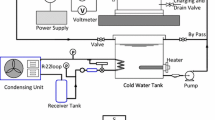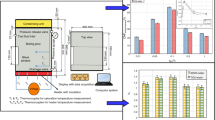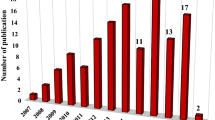Abstract
Enhancing the boiling efficiency helps improve the productivity of thermal systems. Given the effects of added nanoparticles and applied magnetic field on the boiling process, this study investigates the effects of nickel oxide (NiO) nanoparticle concentration with and without applied magnetic field. The studied nanofluid was synthesized by the two-step method and approved by TEM and DLS stability tests for resistance to flocculation. Five concentrations of nanofluid, namely 0.005, 0.01, 0.05, 0.1, and 0.2), were prepared using nanoparticles with an average size of 30 nm. Moreover, a DC magnetic field with a maximum current of 10 A and a strength of 1000 G in the metal core and 300 G at the center of the core was used to evaluate the effects on nanoparticle boiling. The boiling heat transfer coefficient (BHTC) of deionized (DI) water was then compared with a plot of the Rohsenow correlation in three regions to validate the results and showed remarkable consistency. Moreover, experimental data indicated that the magnetic field affected the shape of DI water bubbles during boiling while improving the fluid’s BHTC. It was also found that a 0.005 volume fraction of added NiO nanoparticles results in an average 35 % improvement, whereas at the 0.2 volume fraction, increased sedimentation drastically impacts the BHTC. The magnetic field improved the BHTC by nearly 10 % at a 0.005 volume fraction, while higher concentrations reversed the effects of the magnetic field. By hindering bubble generation, nanoparticle sedimentation on surfaces also drastically affects the BHTC.
















Similar content being viewed by others
Data Availability
Data will be made available on request.
References
S.J. Kim, I.C. Bang, J. Buongiorno, L.W. Hu, Int. J. Heat Mass Transf. (2007). https://doi.org/10.1016/j.ijheatmasstransfer.2007.02.002
X.Q. Wang, A.S. Mujumdar, Braz. J. Chem. Eng. (2008). https://doi.org/10.1590/S0104-66322008000400002
S. Ghasemi, A. Karimipour, Appl. Therm. Eng. 128, 189–197 (2018)
J.M. Wu, J. Zhao, Prog. Nucl. Energy (2013). https://doi.org/10.1016/j.pnucene.2013.03.009
S.M. Kwark, R. Kumar, G. Moreno, J. Yoo, S.M. You, Int. J. Heat Mass Transf. (2010). https://doi.org/10.1016/j.ijheatmasstransfer.2009.11.018
I.L. Pioro, W. Rohsenow, S.S. Doerffer, Int. J. Heat Mass Transf. (2004). https://doi.org/10.1016/j.ijheatmasstransfer.2004.06.019
I. Nkurikiyimfura, Y. Wang, Z. Pan, Renew. Sustain. Energy Rev. (2013). https://doi.org/10.1016/j.rser.2012.12.039
H. Kim, Nanoscale Res. Lett. (2011). https://doi.org/10.1186/1556-276X-6-415
S.U.S. Choi, Z.G. Zhang, W. Yu, F.E. Lockwood, E.A. Grulke, Appl. Phys. Lett. (2001). https://doi.org/10.1063/1.1408272
R.A. Taylor, P.E. Phelan, Int. J. Heat Mass Transf. (2009). https://doi.org/10.1016/j.ijheatmasstransfer.2009.06.040
S. Soltani, S.G. Etemad, J. Thibault, Heat Mass Transf. (2009). https://doi.org/10.1007/s00231-009-0530-9
S. Witharana, Doctoral dissertation, Energiteknik (2003)
M. Kole, T.K. Dey, Appl. Therm. Eng. (2012). https://doi.org/10.1016/j.applthermaleng.2011.10.066
M.B.B. Esfahani, S.M. Sajadi, N.H. Abu-Hamdeh, S. Bezzina, A. Abdollahi, A. Karimipour, F. Ghaemi, D. Baleanu, J. Mol. Liq. (2022). https://doi.org/10.1016/j.molliq.2021.117891
H. Chu, X. Yu, H. Jiang, D. Wang, N. Xu, Int. J. Heat Mass Transf. (2023). https://doi.org/10.1016/j.ijheatmasstransfer.2022.123530
A. Suriyawong, S. Wongwises, Exp. Therm. Fluid Sci. (2010). https://doi.org/10.1016/j.expthermflusci.2010.03.002
P. Vassallo, R. Kumar, S. D’Amico, Int. J. Heat Mass Transf. (2004). https://doi.org/10.1016/S0017-9310(03)00361-2
L. Junhong, G. Jianming, L. Mingqi, L. Hui, L. Zhiwei, J. Heat Transf. ASME (2005). https://doi.org/10.1002/htj.20054
H. Chang, B. Liu, Q. Li, X. Yang, P. Zhou, Int. J. Heat Mass Transf. (2023). https://doi.org/10.1016/j.ijheatmasstransfer.2023.123893
H. Alimoradi, M. Shams, N. Ashgriz, Int. J. Multiph. Flow. (2023). https://doi.org/10.1016/j.ijmultiphaseflow.2022.104350
Funding
Not applicable.
Author information
Authors and Affiliations
Contributions
AA: Formal analysis; Writing—review & editing; Methodology. MBBE: Formal analysis; Writing—review & editing; Methodology. SMS: Formal analysis; Writing—review & editing; Methodology. AS: Formal analysis; Writing—review & editing; Methodology. MS: Formal analysis; Writing—review & editing; Methodology. AK: Formal analysis; Writing—review & editing; Methodology. MI: Formal analysis; Writing—review & editing; Methodology.
Corresponding authors
Ethics declarations
Competing interest
The authors declare that they have no known competing financial interests or personal relationships that could have appeared to influence the work reported in this paper.
Ethical Approval
Not applicable.
Additional information
Publisher's Note
Springer Nature remains neutral with regard to jurisdictional claims in published maps and institutional affiliations.
Rights and permissions
Springer Nature or its licensor (e.g. a society or other partner) holds exclusive rights to this article under a publishing agreement with the author(s) or other rightsholder(s); author self-archiving of the accepted manuscript version of this article is solely governed by the terms of such publishing agreement and applicable law.
About this article
Cite this article
Abdollahi, A., Botlani Esfahani, M.B., Sajadi, S.M. et al. Experimental Study of Pool Boiling Heat Transfer Coefficient for DI-Water-Based Nanofluids Containing Nickel Oxide in a Constant Magnetic Field. Int J Thermophys 44, 62 (2023). https://doi.org/10.1007/s10765-023-03173-7
Received:
Accepted:
Published:
DOI: https://doi.org/10.1007/s10765-023-03173-7




